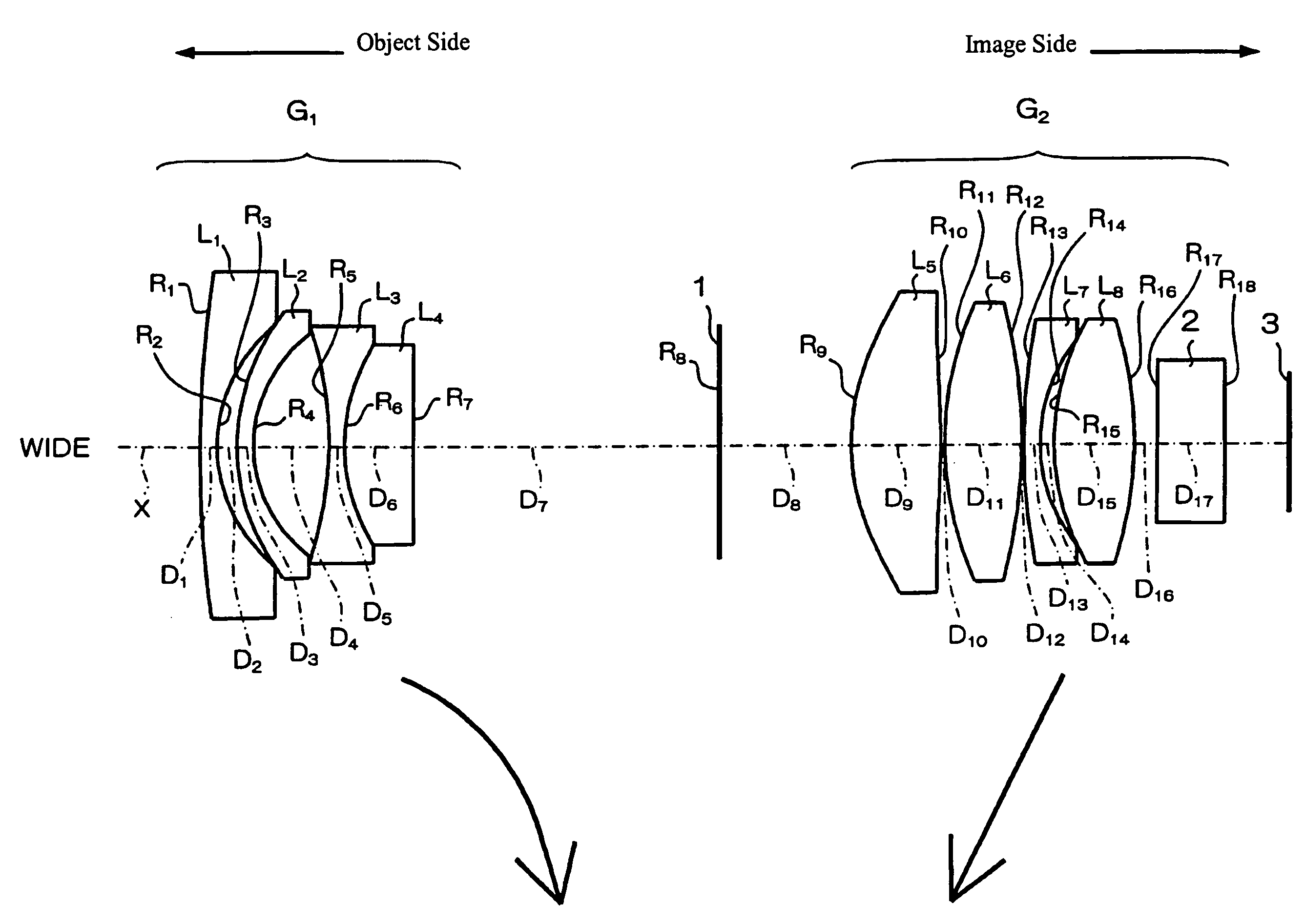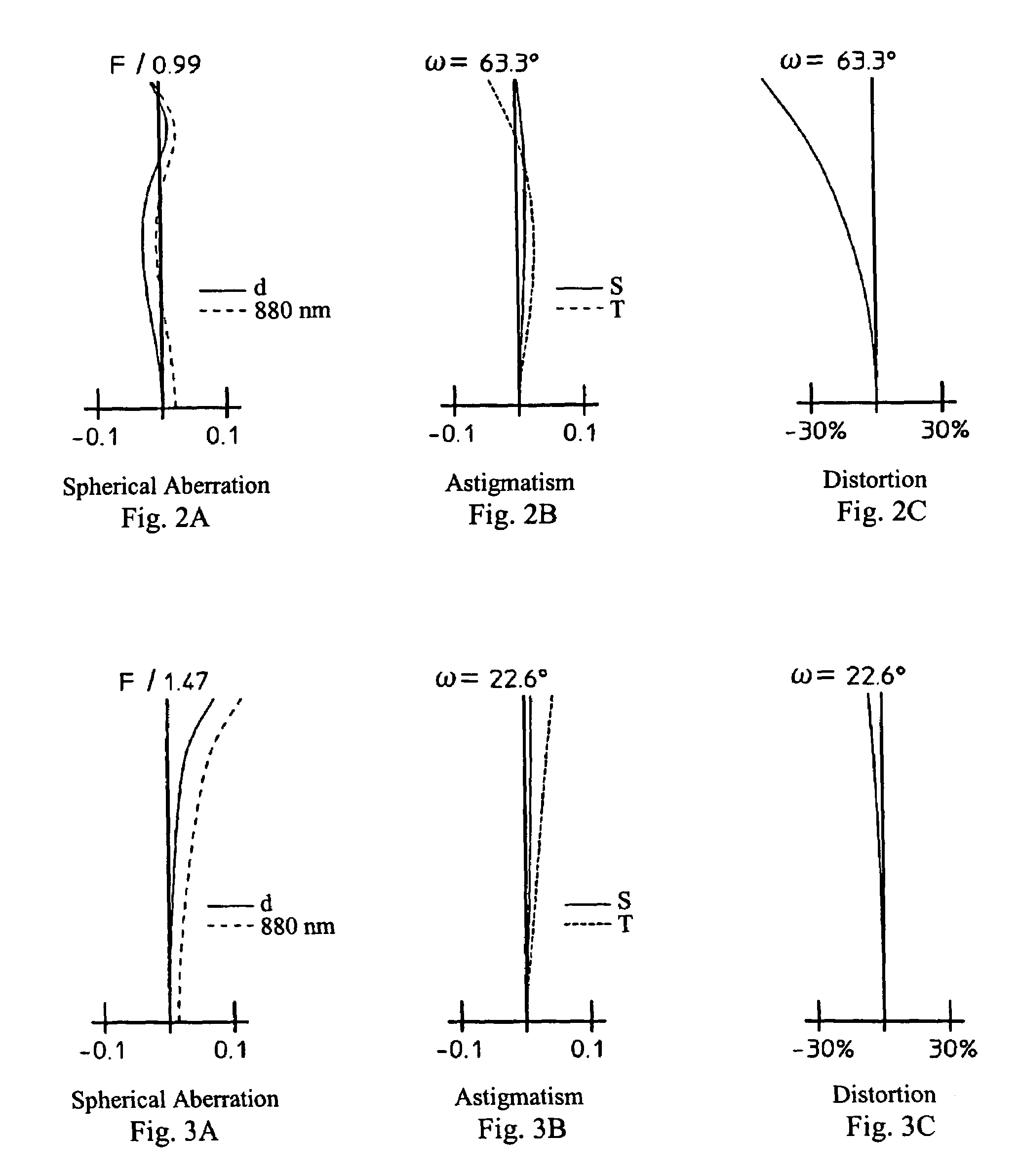Zoom optical system
a technology of optical system and zoom, applied in the field of zoom optical system, can solve the problems of increasing the difficulty of providing good optical performance over the entire zoom range, increasing the difficulty of aberration correction, etc., and achieves good optical performance, comparatively bright imaging, and large aperture
- Summary
- Abstract
- Description
- Claims
- Application Information
AI Technical Summary
Benefits of technology
Problems solved by technology
Method used
Image
Examples
embodiment 1
[0061]FIG. 1 shows a cross-sectional view of Embodiment 1 of the zoom optical system of the present invention at the wide-angle end.
[0062]Table 1 below lists the surface number #, in order from the object side, the radius of curvature R (in mm) of each surface on the optical axis, the on-axis surface spacing D (in mm), as well as the refractive index Nd and the Abbe number vd at the d-line (587.6 nm) of each optical element for Embodiment 1. Note that although R is the on-axis radius of curvature, for convenience of illustration, in FIG. 1 the lead lines from the R reference symbols extend to the surfaces being referenced but do not extend to the on-axis positions.
[0063]
TABLE 1#R.DNdνd 153.70910.781.8340037.2 27.07890.89 39.72060.701.5163364.1 46.28203.34 5−17.07700.701.6727032.1 68.59373.041.9228618.9 7∞D7 (variable) 8∞ (stop)D8 (variable) 9*10.18034.001.5891361.2 10*−34.34020.171115.16543.411.4970081.612−25.17420.101329.06230.701.9228618.9147.51440.631511.35233.511.7291654.716−17....
embodiment 2
[0073]FIG. 4 shows a cross-sectional view of Embodiment 2 of the zoom optical system of the present invention at the wide-angle end.
[0074]Table 5 below lists the surface number #, in order from the object side, the radius of curvature R (in mm) of each surface on the optical axis, the on-axis surface spacing D (in mm), as well as the refractive index Nd and the Abbe number vd at the d-line (587.6 nm) of each optical element for Embodiment 2. Note that although R is the on-axis radius of curvature, for convenience of illustration, in FIG. 4 the lead lines from the R reference symbols extend to the surfaces being referenced but do not extend to the on-axis positions.
[0075]
TABLE 5#RDNdνd 133.51250.781.8340037.2 26.39191.91 314.52810.701.5163364.1 46.43833.10 5−14.61560.701.6727032.1 68.66153.051.9228618.9 7−109.7845D7 (variable) 8∞ (stop)D8 (variable) 9*10.22284.001.5891361.2 10*−33.97550.341113.68153.381.4970081.612−25.09590.121330.78710.701.9228618.9147.17040.591510.66623.391.7291654...
PUM
 Login to View More
Login to View More Abstract
Description
Claims
Application Information
 Login to View More
Login to View More - R&D
- Intellectual Property
- Life Sciences
- Materials
- Tech Scout
- Unparalleled Data Quality
- Higher Quality Content
- 60% Fewer Hallucinations
Browse by: Latest US Patents, China's latest patents, Technical Efficacy Thesaurus, Application Domain, Technology Topic, Popular Technical Reports.
© 2025 PatSnap. All rights reserved.Legal|Privacy policy|Modern Slavery Act Transparency Statement|Sitemap|About US| Contact US: help@patsnap.com



